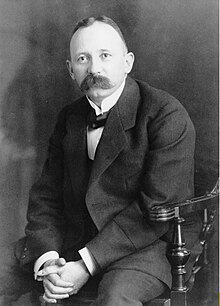Fritz Hofmann (chemist)
Friedrich Hofmann (born November 2, 1866 in Kölleda , † October 29, 1956 in Hanover ) was a chemist and pharmacist .
Life
Fritz Hofmann grew up as the sixth child of a merchant family in Kölleda at Auenstrasse 16, today Professor-Hofmann-Strasse.
After three years of monastery school in Donndorf, he switched to the humanistic grammar school in Schulpforta in 1881 . At the age of 20 he began his apprenticeship in the Ratsapotheke in Göttingen .
After completing his exams as a pharmacist's assistant, he began studying pharmacy at the University of Berlin and after four years acquired his license to practice as a pharmacist, which he immediately enrolled at the University of Rostock . There he stayed from 1894 to 1895 to study chemistry and became Doctor of Philosophy PhD .
On August 1, 1897, he began working as a chemist in the famous paint works in Elberfeld , i.e. in the Wuppertal parent plant of the global Bayer Group. During this time, the talented chemist developed drugs in Arthur Eichengrün's laboratory , such as sleeping pills , anti-malarial drugs and many other pharmaceutical preparations.
In 1906 he left the pharmaceutical and chemical department and in three years developed the world's first process for the production of synthetic rubber , " methyl rubber ". This invention made Fritz Hofmann world famous in 1909. For his many years of research into the production of various types of rubber, he was awarded the gold Emil Fischer Medal from the Association of German Chemists and the honor plaque from the German Rubber Society . From autumn 1918 to October 1934 he was director of the "Silesian Coal Research Institute" of the Kaiser Wilhelm Society in Breslau. On November 2, 1941, he was awarded the Goethe Medal for his life's work in a ceremony in the Aula Leopoldina of the University of Breslau.
His students made the decisive breakthrough in the Buna process.
On his 70th birthday he became an honorary citizen of the city of Wroclaw and his hometown of Kölleda. On the occasion of this anniversary, a plaque of honor was attached to the house where he was born, which can still be seen there today. In Kölleda, on the occasion of his 75th birthday, Auenstrasse, where he spent his earliest childhood, was renamed Prof.-Hofmann-Strasse on November 1, 1941.
The newspaper wrote about this at the time:
" With the renaming we are fulfilling our esteemed honorary citizen Prof. Dr. Dr. A natural duty of grateful piety towards Hofmann. May the Prof.-Hofmann-Straße convey the name of the famous scholar and inventor to later generations and especially encourage the sons of our city, which fate leads abroad, to become men of their own strength and to remain loyal to their homeland. "
In 1945 he returned to Kölleda and worked in the field of cancer research. In Kölleda the state high school “Prof. F. Hofmann ” his name.
swell
- Manfred Rasch : The Silesian Coal Research Institute of the Kaiser Wilhelm Society. In: The Kaiser Wilhelm / Max Planck Society and its institutes. Berlin 1996.
literature
- Werner Hofmann: Hofmann, Friedrich. In: New German Biography (NDB). Volume 9, Duncker & Humblot, Berlin 1972, ISBN 3-428-00190-7 , p. 452 f. ( Digitized version ).
Individual evidence
- ↑ Registration of Fritz Hofmann in the Rostock matriculation portal .
- ^ Labor Eichengrün at Bayer ( Memento from September 28, 2007 in the Internet Archive ).
- ↑ Patent DE250690 : Process for the production of artificial rubber. Published on September 6, 1912 , applicant: Farbenfabriken, vorm. Friedr. Bayer & Co. in Elberfeld.
- ↑ Patent DE250335 : Method for the representation of a substance close to rubber. Published on September 6, 1912 , applicant: Farbenfabriken, vorm. Friedr. Bayer & Co. in Elberfeld.
- ↑ Patent DE265221 : Process to accelerate the vulcanization of natural or artificial rubber types. Published on October 3, 1913 , applicant: Farbenfabriken, vorm. Friedr. Bayer & Co. in Leverkusen b. Cologne and Elberfeld.
- ↑ Hofmann's heirs. Lanxess , accessed July 24, 2017 .
Web links
- Literature by and about Fritz Hofmann in the catalog of the German National Library
- Information on synthetic rubber with reference to Fritz Hofmann , last accessed: April 25, 2007
- Biography Bayer
- Newspaper article about Fritz Hofmann in the 20th century press kit of the ZBW - Leibniz Information Center for Economics .
| personal data | |
|---|---|
| SURNAME | Hofmann, Fritz |
| ALTERNATIVE NAMES | Hofmann, Friedrich |
| BRIEF DESCRIPTION | German chemist, inventor of rubber |
| DATE OF BIRTH | November 2, 1866 |
| PLACE OF BIRTH | Koelleda |
| DATE OF DEATH | October 29, 1956 |
| Place of death | Hanover |
